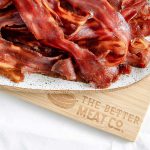3 Leading Applications for Hemp Protein
SPONSORED CONTENT FROM Applied Food Sciences, Inc.
Grocery sales of plant-based foods that directly replace animal products grew to over $7 billion in the past year [i]. The astonishing 27% growth is a testament to the innovation in this space. Needless to say, there is a lot of excitement around the opportunity for plant-based protein. However, the industry must respond with more diversity in supportive ingredients to sustain the growing demand. Enter hemp seed protein. Hemp grain is one of the most sustainable and nutritious new protein sources. Advancement in extraction has this ingredient looking and tasting great as a perfect complement for alternative meats, baked goods, and other non-dairy innovations.
Hemp seeds are a nutritional powerhouse full of proteins, amino acids, polyunsaturated fatty acids, vitamins, and minerals, making them an attractive option for plant-based foods. A common misconception is that hemp seed protein is green and bitter. On the contrary, most hemp protein ingredients today will utilize the dehulled “hemp heart,” the seed’s inner white core, resulting in a nutritionally rich protein that is mainly tasteless and colorless for a smoother sensory experience across many applications. Hemp protein contains all nine essential amino acids that meet the requirements for adults and adolescents recommended by the World Health Organization (WHO) in the PDCAAS score. Removing the hulls (shell) prior to protein extraction has also been shown to improve protein digestibility [ii-iv].
So what applications work best for hemp seed protein? Hemp seeds have diverse functional properties like binding, foaming, gelation, and emulsification that are superior to many plant-based options. Whether making a muffin, extruded puff snack, or alternative meat product, formulators can improve their recipes with hemp seed protein in the mix.

The Heart of Plant-Based Meats
Meat substitutes (e.g., meat analogues, alternative meats, meatless products, etc.) are at an all-time high in consumer interest. IRI reports that 58% of consumers want to increase plant-based food intake. Meanwhile, a recent YouGov survey states that 40% of consumers aged 18–44 eat meat substitutes at least once per month [v]. For most consumers, the importance of meat alternatives is not about eliminating animal products but rather diversifying their diet and adopting more of a “flexitarian” lifestyle. Thankfully consumers have lots of accessibility as many new plant-based options are emerging in the market each year. Impossible Foods, for instance, sells its plant-based line to over 20,000 grocery stores and 40,000 restaurants [vi]. The company’s 2021 sales were up 85% over the previous year attributing much of its success to the convenience of accessibility.
Behind the booming success of alternative meats is the science of making plant proteins look and taste like actual meat. Although there have been numerous technological advancements in manufacturing meat analogues, extrusion remains the most extensively used method for plant-based materials. Extrusion is a process that utilizes high heat and pressure to bind vegetable protein with water resulting in a texturized product with a fibrous consistency similar to animal meat [vii-ix]. Ingredient properties play a tremendous role in obtaining realistic meat textures. What is unique about hemp seed protein is its exceptional emulsification and gelling properties, which results in a juicier, more authentic bite and mouthfeel.
The science in generating meat analogues is advancing at a rapid rate. For hemp protein, new research was recently published on an emerging new ingredient, PurHP-75™ organic hemp seed protein by Applied Food Sciences (AFS). The study found that PurHP-75™ worked exceptionally well in a blend with a pea protein isolate. The addition of PurHP-75™ led to improvements in the dietary fiber content compared to the control while not impacting the sensory attributes of the final product. In addition, the project achieved the highest rating in meat-like texture. The results showed that hemp seed protein is a promising new sustainable plant-based protein to develop more nutritious high-moisture meat analogues at different ratios, barrel temperatures, and feed moisture contents.

Plant Baked Goods – A Recipe for Success
Protein plays a considerable role in baked snacks and foods. Beyond adding nutritional value, proteins work with starches, fats, sugars, and leavening agents, to perform a delicate balancing act responsible for conditioning dough, providing structure, and enhancing texture [x]. But plant proteins will undoubtedly influence the end product’s texture, taste, and appearance differently from animal proteins such as casein, whey, and eggs. So whether a baked good is a bar, pancake, extruded snack, tortilla, etc., it is important to recognize that plant-based ingredients have some notable hurdles to overcome.
But what is the solution? Many plant protein ingredients take a common approach to isolate only the protein, removing much of the other functional compounds to mitigate these undesired sensory characteristics. Unfortunately, while it may help with flavor and texture, isolating protein nullifies much of the attraction of being “plant-based.” Unlike many protein isolates, hemp seeds net a concentrated protein with a standardized amount of dietary fibers and an extensive spectrum of fatty acids. The functional properties of hemp seed protein, such as water-holding for moisture, emulsifying, and gelling, make for a fantastic ingredient that can support a diverse range of baking applications. Hemp seed protein is especially suited for puffed extruded snacks.

Non-Dairy Product Innovation
Let’s appreciate the complexity and chemistry of non-dairy products. Plant-based milk, frozen treats, cheeses, yogurts, and spreads all require a precise blend of proteins, emulsifiers, and fats to bind ingredients, create structure, and retain moisture, all without impacting the texture and flavor of the finished product. Fortunately, hemp seed protein has impressive emulsification and foaming properties that play an important role in formulating stable and homogenous food products.
Of course, we cannot forget about flavor. The sensory characteristics of hemp seed protein have been the main impediment to its adoption in the market thus far. For hemp seed protein, the solution is removing the outer shell (or hull) to present a clean ingredient that is white instead of green and void of the bitter flavor traditionally associated with hemp protein. Hemp seed proteins that only utilize the hemp hearts can deliver delicious creamy sensory characteristics for plant-based milk, yogurt, cheese, ice cream, and spreads.
Sourcing the Best Hemp Seed Protein
With a cutting-edge portfolio of ingredients and over two decades of experience, Applied Food Sciences manufactures some of the most widely used functional extracts in the natural products industry. PurHP-75™ organic hemp seed protein is the latest example of the company’s innovative and on-trend products.
PurHP-75™ organic hemp heart protein is a new plant-based ingredient standardized to 75% protein, complete with all nine essential amino acids. The quality of protein in PurHP-75™ is considerably higher in purity than other hemp ingredients due to the latest advancements in dehulling and state-of-the-art sorting technology. The extraction process results in a concentrated protein powder with a fluffy white consistency, deliciously creamy texture, zero odor, and a neutral taste profile.
“We wanted to create something that was food-driven,” reports Jackson Zapp, VP of innovation at Applied Food Sciences (AFS). “So for PurHP-75™, texture and flavor were paramount. We had to remove the outer shell of the hemp seeds and sort out any green particulates to extract the highest purity hemp seed protein available today. The result is a highly digestible protein with superior sensory attributes that works perfectly in many food applications.”
If you are developing a plant-based food, white papers and application guides for PurHP-75™ can be found on the company’s website (https://appliedfoods.com), including a form you can fill out to request samples.
Citations:
i. SPINS retail sales data, April 6, 2021
ii. Boukid, F. Plant-based meat analogues: from niche to mainstream. 2021. European Food Research and Technology, 247, pp. 297-308.
iii. Shen, P., Gao, Z., Fang, B., Rao, J., and Chen, B. 2021. Ferreting out the secrets of industrial hemp protein as emerging functional food ingredients. Trends in Food Science & Technology, 112, pp. 1-15.
iv. Wang, Q. and Xiong, Y.L. 2019. Processing, nutrition, and functionality of hempseed protein: A review. Comprehensive Reviews in Food Science and Food Safety, 18, pp. 936-952.
v. Nguyen, Hoang. What’s driving consumer desire for meatless products? 2022.
vi. Tepper, Taylor. 2022. Impossible Foods IPO: What You Need To Know.
vii. Ferawati, F., Zahari, I., Barman, M., Hefni, M., Ahlstrom, C., Witthof, C., and Ostbring, K. 2021. High-moisture meat analogues produced from yellow pea and faba bean protein isolates/concentrates: Effect of raw material composition and extrusion parameters on texture properties. Foods, 10, 843.
viii. Ubbink, J. and Munialdin, B. Protein physical state in meat analogue processing. 2022. Current Opinion in Food Science, 45, 100822.
ix. Vatansever, S., Tulbek, M.C., and Riaz, M.N. 2020. Low- and high-moisture extrusion of pulse proteins as plant-based meat ingredients: A review. Cereal FoodsWorld, 65.
x. Larsen, Linda. The Science Behind Common Baking Ingredients. November 2019
















